

Strategies vs. Models. When I travel around the country and visit teachers in classrooms, one of the things I notice is that the word strategy and model are sometimes used interchangeably.
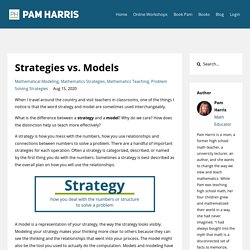
What is the difference between a strategy and a model? Twitter. The Power of Conceptual Understanding. A lot of my success as a math student was due to rote memorization.

Twitter. Twitter. Resource Alert: Nix the Tricks! De-emphasizing Speed in Math. Balancing Act: Understanding Equality. Understand the meaning of the equal sign, and determine if equations involving addition and subtraction are true or false.
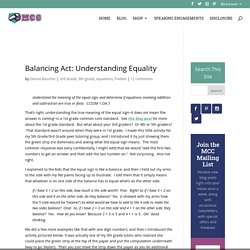
CCSSM 1.OA.7 That’s right, understanding the true meaning of the equal sign–it does not mean ‘the answer is coming’–is a 1st grade common core standard. Hey Twitter! Who’s got a great video for teachers about the difference between concept vs. procedure development in math? Teaching Computation in the Twenty-First Century — CGI Math Teacher Learning Center. By Linda Levi, Director CGI Math Teacher Learning Center When our parents (and some of us) were in school, standard algorithms were taught so that people were able to add, subtract, multiply and divide fairly quickly and accurately.
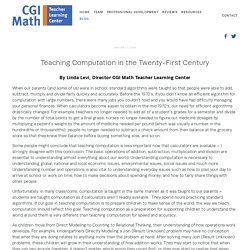
Before the 1970’s, if you didn’t know an efficient algorithm for computation with large numbers, there were many jobs you couldn’t hold and you would have had difficulty managing your personal finances. What Happened to Math Class? I recently facilitated this information sessions for parents and educators to help them understand the changes in mathematics education and had the session recorded so I could share it with you.
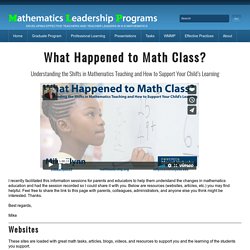
Below are resources (websites, articles, etc.) you may find helpful. Feel free to share the link to this page with parents, colleagues, administrators, and anyone else you think might be interested. Thanks. Best regards, 12 Math Rules That Expire in the Middle Grades. Many rules taught in mathematics classrooms “expire” when students develop knowledge that is more sophisticated, such as using new number systems.
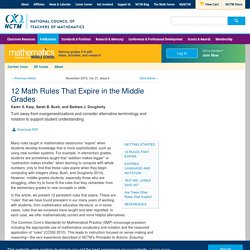
For example, in elementary grades, students are sometimes taught that “addition makes bigger” or “subtraction makes smaller” when learning to compute with whole numbers, only to find that these rules expire when they begin computing with integers (Karp, Bush, and Dougherty 2014). However, middle-grades students, especially those who are struggling, often try to force-fit the rules that they remember from the elementary grades to new concepts or skills. In this article, we present 12 persistent rules that expire. These are “rules” that we have found prevalent in our many years of working with students, from mathematics education literature, or in some cases, rules that we ourselves have taught and later regretted.
The next sentence in the article says: “The U.S. has more memorizers than most other countries in the world.” #NixTheTricks… Why We Should Reconsider Using Worksheets (And What We Should Be Doing Instead) Planning Number Talks with the Four Stages of Using Models. (This post is re-blogged from my other math blog.)
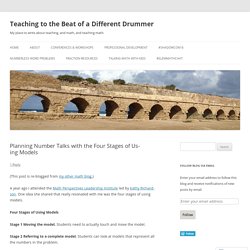
A year ago I attended the Math Perspectives Leadership Institute led by Kathy Richardson. One idea she shared that really resonated with me was the four stages of using models. Four Stages of Using Models Stage 1 Moving the model. Students need to actually touch and move the model. Stage 2 Referring to a complete model. Stage 3 Referring to a partial model. Stage 4 Solving the problem mentally. Kathy Richardson went on to share the following points about the importance of models: Strategies to #shiftthelift in Mathematics @achievethecore… Just finished my book and was figuring out what to read next. Then this came. □❤…
Skip the Tricks Build Real Understanding in Mathematics. The Path to Unitizing. Do your students still use their fingers or count manipulatives to solve simple math problems?

Our goal as teachers is to provide math experiences in which students understand numbers and their relationships in order to solve problems using non count-by-one strategies. Robert J. Wright, et al., 2012, in the book, Developing Number Knowledge, states: Professional Development: What should it look like? A few weeks ago Michael Fenton asked on his blog this question: Suppose a teacher gets to divide 100% between two categories: teaching ability and content knowledge.

What’s the ideal breakdown? The question sparked many different answers that showed a very wide range of thinking, from 85%/15% favouring content, to 100% favouring pedagogy. In general though, it seems that more leaned toward the pedagogy side than the content side. Skip the Tricks Build Real Understanding in Mathematics. The Elusive Search for Balance - National Council of Teachers of Mathematics. By Matt Larson, NCTM PresidentFebruary 20, 2017 In a recent President’s blog post on the need to make homework comprehensible, I referred to the Fordham Institute Report, Common Core Math in the K–8 Classroom: Results from a National Survey. The report offers another interesting finding: “The math wars aren’t over.” The Elusive Search for Balance - National Council of Teachers of Mathematics. Paying Attention to OUR Understanding! I believe one of the most important things we can do as math teachers is to constantly deepen our understanding of the concepts our students are learning.
In my 2nd year of teaching I was assigned to teach a grade 6/7 split class with 35 students. Addition and Subtraction. Why CRA? When You Multiply by 10, Just Add a Zero? Horrors!?! We Ask, We Listen, We Learn is one of the early blog posts I wrote.
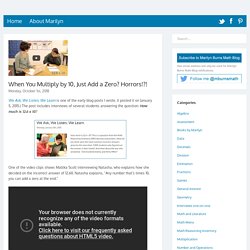
The Problem with using Acromyms & Mnemonic Devices – Those who teach do more. Search Results. Subtraction: More Than Just Taking Away - Well-Trained Mind. Can you tell what these three word problems have in common? I had 8 cookies, and then I ate 5. How many cookies did I have left? I have 8 cookies. 5 are chocolate, and the rest are oatmeal raisin.
How many are oatmeal raisin? There are 8 chocolate cookies and 5 sugar cookies in the cookie jar. TEDxOrangeCoast - Matthew Peterson - Teaching Without Words. How Many More? - Math Coach's Corner. Making Math Moments Matter With The Concreteness Fading Model. Importance of Context and Concrete Manipulatives From Kindergarten Through Grade 12 During the first half of my teaching career, I would spend what seemed to be the first half of a math lesson teaching a new math concept by sharing definitions, formulas, steps and procedures. Two Common Misconceptions About Learning. Direct Instruction...Do We Need It? The role of “practice” in mathematics class. A few weeks ago a NYTimes published an article titled, Make Your Daughter Practice Math.
What Does Fluency Without Understanding Look Like? Concrete Representational Abstract (CRA) in mathematics.